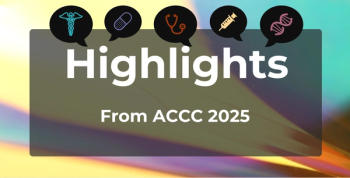
Ending the HIV Epidemic Calls for Flexibility and Innovation, Panel Emphasizes
The US government's Ending the HIV Epidemic: A Plan for America, is founded on 4 pillars: diagnose, treat, prevent, respond. The goals of this program are to reduce new HIV infections by 75% by 2025 and by 90% by 2030.
The US government's Ending the HIV Epidemic: A Plan for America, is both ambitious and systematic. The goal of reducing new
- Diagnose through increased HIV testing, as early as possible, and link HIV-positive individuals to care
- Treat HIV rapidly and effectively so they can achieve and maintain viral suppression
- Prevent transmission of the virus through access to pre-exposure prophylaxis (PrEP) and syringe services programs
- Respond to HIV outbreaks with prevention and treatment services
First announced in February 2019 and launched in December, the plan seeks to bring new HIV infections down 90% over the next decade by prioritizing those who are most vulnerable and account for more than 50% of new HIV cases.
In a satellite session on day 1 of AIDS 2020, “Ending the HIV Epidemic: A Plan for America: A Conversation,” Harold Phillips, chief operating officer for Ending the HIV Epidemic (EHE) in the Office of the Assistant Secretary for Health, HHS, moderated a discussion on how EHE’s mission is being carried out, as well as how it has been affected by the coronavirus disease 2019 (COVID-19) pandemic. He was joined by representatives from the 5 other federal agencies tasked with implementing this initiative:
- Carl Dieffenbach, PhD, director of the Division of AIDS, National Institute of Allergy and Infectious Diseases, National Institutes of Health
- Rick Haverkate, MPH, national HIV/AIDS program director, Indian Health Service
- Eugene McCray, MD, director, Division of HIV Prevention, National Center for HIV/AIDS, Viral Hepatitis, STD and TB Prevention, CDC
- Laura Cheever, MD, ScM, associate administrator, HIV/AIDS Bureau, Health Resources and Services Administration (HRSA)
- Neeraj Gandotra, MD, chief medical officer, Substance Abuse and Mental Health Services Administration (SAMHSA)
Dieffenbach kicked off the discussion with Phillips by discussing how research can help optimize the implementation of interventions aimed at HIV prevention and treatment.
“It's very important that we be able to bring the interventions to the people who need them most,” he stated. “We're seeking to create partnerships, as well as train, consult, and provide technical assistance on implementation and science strategies.”
Dieffenbach emphasized how research can help to identify gaps in both medicine and health care delivery, as well as that collaboration is vitally important disseminate information and deliver interventions to the most vulnerable patient populations.
Haverkate was up next, talking about the disproportionate effect that the overlap of HIV and COVID-19 has had on the Native American community, both due to an unfortunate and longstanding lack of inadequate access to health care, while also noting that it’s too soon to tell of the far-reaching impact. He said COVID-19 has commandeered resources away from the HIV space, chiefly in the form of human capital, as well as reduced face-to-face visits with only mail-order prescription refills now offered.
“One program we surveyed noted a likely increase in substance use among their HIV patient cohort and another that initiation of PrEP services has decreased,” he said, “but telemedicine for ART [antiretroviral treatment] has seen a 73% increase. It appears that ART programs and patients have implemented an impressive set of compensatory strategies for the delivery of care.”
McCray emphasized Haverkate’s findings that COVID-19 has somewhat pushed aside HIV outreach and prevention efforts. “Intervention specialists, traditionally tasked with doing a lot of our HIV contact tracing work, as well as STD contact tracing work, have been largely redirected to COVID doing contact tracing, because they really are the best at doing that kind of work,” he pointed out.
Flexibility is of the utmost importance now in implementing creative solutions to deal with service disruption in HIV, and McCray highlighted the necessity of scaling up self-testing initiatives through such efforts as self-collection and drive-through testing, as well as providing 90-day PrEP prescriptions instead of the usual 30 days.
To continue to help the EHE initiative move forward, Cheever, who is also charged with leading the Ryan White HIV/AIDS Program, detailed the $170-million grant HRSA awarded the program to expand access to HIV care, treatment, and prevention services specifically to address the goals of EHE. She also told of how the Ryan White Program’s predominantly racial and ethnic patient population has an 87% viral suppression rate from accessing care just 1 time.
“I really attribute that to the fact that in addition to providing free or low cost medical services, the program integrates essential support services such as mental health, substance use, and housing services,” she stated, “which help us reduce the disparities for people with HIV and enable them to live long, healthy, and meaningful lives.”
Cheever also talked innovating care delivery in the time of COVID-19 and how important it is that evidence-informed interventions reach underserved populations through EHE. This can be accomplished through education, training, expanded community outreach via increasing routine and risk-based HIV testing, and providing PrEP in the primary care setting to the patient groups most at risk for acquiring HIV.
“[COVID-19 has] really disrupted our normal operations but also forced us to find new ways to do our work,” she said, “and many of the innovations that have come about will really be able to accelerate our work and meeting the challenges of EHE.”
SAMHSA’s Gandotra completed the panel and stressed that the complex interplay among mental illness, substance use disorder, and HIV typically serves as a roadblock to initiating access to treatment for HIV. But he said that addressing all 3 can help to reduce HIV-related health disparities; again, flexibility is the key to service delivery.
“We know that if we engage individuals in treatment, that can serve as prevention. We can place them on the treatment continuum and minimize their continued risky behavior,” he stated. “Most importantly, we transmit those benefits to the community. Risk reduction allows for a comprehensive approach through changing substance-related behaviors and sex-related behaviors.”
Much progress has been made, but there is so much more work to be done, the panel seemed to agree upon. Innovation and flexibility are key to EHE’s success in the time of COVID-19.
Newsletter
Stay ahead of policy, cost, and value—subscribe to AJMC for expert insights at the intersection of clinical care and health economics.









































